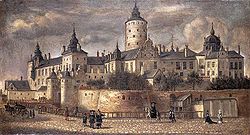Ó┤òÓÁìÓ┤░Ó┤┐Ó┤©ÓÁìÓ┤▒ÓÁìÓ┤▒ÓÁÇÓ┤¿,Ó┤òÓÁìÓ┤ÁÓÁÇÓÁ╗ Ó┤ôÓ┤½ÓÁì Ó┤©ÓÁìÓ┤ÁÓÁÇÓ┤íÓÁ╗
1632 Ó┤«ÓÁüÓ┤ñÓÁ¢ 1654-ÓÁ¢ Ó┤©ÓÁìÓ┤ÑÓ┤¥Ó┤¿Ó┤«ÓÁèÓ┤┤Ó┤┐Ó┤»ÓÁüÓ┤¿ÓÁìÓ┤¿Ó┤ñÓÁì Ó┤ÁÓ┤░ÓÁå Ó┤©ÓÁìÓ┤ÁÓÁÇÓ┤íÓ┤¿Ó┤┐Ó┤▓ÓÁå Ó┤░Ó┤¥Ó┤£ÓÁìÓ┤×Ó┤┐Ó┤»Ó┤¥Ó┤»Ó┤┐Ó┤░ÓÁüÓ┤¿ÓÁìÓ┤¿ÓÁü Ó┤òÓÁìÓ┤░Ó┤┐Ó┤©ÓÁìÓ┤▒ÓÁìÓ┤▒ÓÁÇÓ┤¿,Ó┤òÓÁìÓ┤ÁÓÁÇÓÁ╗ Ó┤ôÓ┤½ÓÁì Ó┤©ÓÁìÓ┤ÁÓÁÇÓ┤íÓÁ╗.(Ó┤©ÓÁìÓ┤ÁÓÁÇÓ┤íÓ┤┐Ó┤ÀÓÁì: Ó┤òÓÁìÓ┤░Ó┤┐Ó┤©ÓÁìÓ┤▒ÓÁìÓ┤▒ÓÁÇÓ┤¿, 18 Ó┤íÓ┤┐Ó┤©Ó┤éÓ┤¼ÓÁ╝ 1626 - 19 Ó┤ÅÓ┤¬ÓÁìÓ┤░Ó┤┐ÓÁ¢ 1689)[a]1632-ÓÁ¢ Ó┤▓ÓÁéÓ┤▒ÓÁìÓ┤▒ÓÁìÔÇîÓ┤©ÓÁ╗ Ó┤»ÓÁüÓ┤ªÓÁìÓ┤ºÓ┤ñÓÁìÓ┤ñÓ┤┐ÓÁ¢ Ó┤«Ó┤░Ó┤úÓ┤¬ÓÁìÓ┤¬ÓÁåÓ┤ƒÓÁìÓ┤ƒ Ó┤ñÓ┤¿ÓÁìÓ┤▒ÓÁå Ó┤¬Ó┤┐Ó┤ñÓ┤¥Ó┤ÁÓÁì Ó┤ùÓÁüÓ┤©ÓÁìÓ┤ñÓ┤¥Ó┤ÁÓ┤©ÓÁì Ó┤àÓ┤íÓÁïÓÁ¥Ó┤½Ó┤©Ó┤┐Ó┤¿ÓÁìÓ┤▒ÓÁå Ó┤¬Ó┤┐ÓÁ╗Ó┤ùÓ┤¥Ó┤«Ó┤┐Ó┤»Ó┤¥Ó┤»Ó┤┐ Ó┤àÓ┤ºÓ┤┐Ó┤òÓ┤¥Ó┤░Ó┤«ÓÁçÓ┤▒ÓÁìÓ┤▒ÓÁåÓ┤ƒÓÁüÓ┤ñÓÁìÓ┤ñ Ó┤àÓ┤ÁÓÁ╝ Ó┤¬Ó┤ñÓ┤┐Ó┤¿ÓÁåÓ┤ƒÓÁìÓ┤ƒÓ┤¥Ó┤é Ó┤ÁÓ┤»Ó┤©ÓÁìÓ┤©Ó┤┐ÓÁ¢ 1644-ÓÁ¢ Ó┤©ÓÁìÓ┤ÁÓÁÇÓ┤íÓ┤┐Ó┤ÀÓÁì Ó┤©Ó┤¥Ó┤«ÓÁìÓ┤░Ó┤¥Ó┤£ÓÁìÓ┤»Ó┤é Ó┤¡Ó┤░Ó┤┐Ó┤òÓÁìÓ┤òÓ┤¥ÓÁ╗ Ó┤ñÓÁüÓ┤ƒÓ┤ÖÓÁìÓ┤ÖÓ┤┐.[7] Ó┤òÓÁìÓ┤░Ó┤┐Ó┤©ÓÁìÓ┤▒ÓÁìÓ┤▒ÓÁÇÓ┤¿ Ó┤¬Ó┤ñÓ┤┐Ó┤¿ÓÁçÓ┤┤Ó┤¥Ó┤é Ó┤¿ÓÁéÓ┤▒ÓÁìÓ┤▒Ó┤¥Ó┤úÓÁìÓ┤ƒÓ┤┐Ó┤▓ÓÁå Ó┤ÅÓ┤▒ÓÁìÓ┤▒Ó┤ÁÓÁüÓ┤é Ó┤òÓÁéÓ┤ƒÓÁüÓ┤ñÓÁ¢ Ó┤àÓ┤▒Ó┤┐Ó┤ÁÓÁüÓ┤¿ÓÁçÓ┤ƒÓ┤┐Ó┤» Ó┤©ÓÁìÓ┤ñÓÁìÓ┤░ÓÁÇÓ┤òÓ┤│Ó┤┐ÓÁ¢ Ó┤ÆÓ┤░Ó┤¥Ó┤│Ó┤¥Ó┤»Ó┤┐ Ó┤ôÓÁ╝Ó┤«ÓÁìÓ┤«Ó┤┐Ó┤òÓÁìÓ┤òÓ┤¬ÓÁìÓ┤¬ÓÁåÓ┤ƒÓÁüÓ┤¿ÓÁìÓ┤¿ÓÁü.[8] Ó┤¬ÓÁüÓ┤©ÓÁìÓ┤ñÓ┤òÓ┤ÖÓÁìÓ┤ÖÓÁ¥, Ó┤òÓÁêÓ┤»ÓÁåÓ┤┤ÓÁüÓ┤ñÓÁìÓ┤ñÓÁüÓ┤¬ÓÁìÓ┤░Ó┤ñÓ┤┐Ó┤òÓÁ¥, Ó┤¬ÓÁåÓ┤»Ó┤┐Ó┤¿ÓÁìÓ┤▒Ó┤┐Ó┤éÓ┤ùÓÁüÓ┤òÓÁ¥, Ó┤ÂÓ┤┐ÓÁ¢Ó┤¬ÓÁìÓ┤¬Ó┤ÖÓÁìÓ┤ÖÓÁ¥ Ó┤ÄÓ┤¿ÓÁìÓ┤¿Ó┤┐Ó┤ÁÓ┤»ÓÁïÓ┤ƒÓÁü Ó┤ÁÓ┤│Ó┤░ÓÁåÓ┤»Ó┤ºÓ┤┐Ó┤òÓ┤é Ó┤çÓ┤ÀÓÁìÓ┤ƒÓ┤é Ó┤¬ÓÁìÓ┤░Ó┤òÓ┤ƒÓ┤┐Ó┤¬ÓÁìÓ┤¬Ó┤┐Ó┤ÜÓÁìÓ┤ÜÓ┤┐Ó┤░ÓÁüÓ┤¿ÓÁìÓ┤¿ÓÁü. Ó┤«Ó┤ñÓ┤é, Ó┤ñÓ┤ñÓÁìÓ┤ñÓÁìÓ┤ÁÓ┤ÜÓ┤┐Ó┤¿ÓÁìÓ┤ñ, Ó┤ùÓ┤úÓ┤┐Ó┤ñÓ┤ÂÓ┤¥Ó┤©ÓÁìÓ┤ñÓÁìÓ┤░Ó┤é, Ó┤åÓÁ¢Ó┤òÓÁìÓ┤òÓÁåÓ┤«Ó┤┐ Ó┤ñÓÁüÓ┤ƒÓ┤ÖÓÁìÓ┤ÖÓ┤┐Ó┤»Ó┤ÁÓ┤»Ó┤┐Ó┤▓ÓÁüÓ┤│ÓÁìÓ┤│ Ó┤ñÓ┤¥Ó┤ñÓÁìÓ┤¬Ó┤░ÓÁìÓ┤»Ó┤é Ó┤«ÓÁéÓ┤▓Ó┤é, Ó┤©ÓÁìÓ┤▒ÓÁìÓ┤▒ÓÁïÓ┤òÓÁìÓ┤òÓÁìÓ┤╣ÓÁïÓ┤«Ó┤┐Ó┤▓ÓÁå Ó┤¬Ó┤▓ Ó┤ÂÓ┤¥Ó┤©ÓÁìÓ┤ñÓÁìÓ┤░Ó┤£ÓÁìÓ┤×Ó┤░ÓÁåÓ┤»ÓÁüÓ┤é Ó┤àÓ┤ÁÓÁ╝ Ó┤åÓ┤òÓÁ╝Ó┤ÀÓ┤┐Ó┤òÓÁìÓ┤òÓÁüÓ┤òÓ┤»ÓÁüÓ┤é Ó┤¿Ó┤ùÓ┤░Ó┤é "Ó┤¿ÓÁïÓÁ╝Ó┤ñÓÁìÓ┤ñÓÁì Ó┤ÅÓ┤ÑÓÁ╗Ó┤©ÓÁì" Ó┤åÓ┤»Ó┤┐Ó┤ñÓÁìÓ┤ñÓÁÇÓ┤░Ó┤¥Ó┤¿ÓÁüÓ┤é Ó┤åÓ┤ùÓÁìÓ┤░Ó┤╣Ó┤┐Ó┤ÜÓÁìÓ┤ÜÓÁü. Ó┤àÓ┤ÁÓÁ╝ Ó┤¼ÓÁüÓ┤ªÓÁìÓ┤ºÓ┤┐Ó┤»ÓÁüÓ┤│ÓÁìÓ┤│Ó┤ÁÓ┤│ÓÁüÓ┤é Ó┤ÜÓ┤×ÓÁìÓ┤ÜÓ┤▓Ó┤ÜÓ┤┐Ó┤ñÓÁìÓ┤ñÓ┤»ÓÁüÓ┤«Ó┤¥Ó┤»Ó┤┐Ó┤░ÓÁüÓ┤¿ÓÁìÓ┤¿ÓÁü. 1654-ÓÁ¢ Ó┤àÓ┤ÁÓÁ╝ Ó┤ÆÓ┤░ÓÁü Ó┤àÓ┤¬Ó┤ÁÓ┤¥Ó┤ªÓ┤ñÓÁìÓ┤ñÓ┤┐ÓÁ¢Ó┤¬ÓÁìÓ┤¬ÓÁåÓ┤ƒÓÁüÓ┤òÓ┤»ÓÁüÓ┤é Ó┤ñÓÁüÓ┤ƒÓÁ╝Ó┤¿ÓÁìÓ┤¿ÓÁì Ó┤àÓ┤ÁÓ┤┐Ó┤ÁÓ┤¥Ó┤╣Ó┤┐Ó┤ñÓ┤»Ó┤¥Ó┤»Ó┤┐Ó┤░Ó┤┐Ó┤òÓÁìÓ┤òÓ┤¥ÓÁ╗ Ó┤ñÓÁÇÓ┤░ÓÁüÓ┤«Ó┤¥Ó┤¿Ó┤┐Ó┤òÓÁìÓ┤òÓÁüÓ┤òÓ┤»ÓÁüÓ┤é [9] Ó┤àÓ┤ÁÓÁ╝ Ó┤ñÓ┤¿ÓÁìÓ┤▒ÓÁå Ó┤©Ó┤┐Ó┤éÓ┤╣Ó┤¥Ó┤©Ó┤¿Ó┤é Ó┤ëÓ┤¬ÓÁçÓ┤òÓÁìÓ┤ÀÓ┤┐Ó┤òÓÁìÓ┤òÓÁüÓ┤òÓ┤»ÓÁüÓ┤é Ó┤▒ÓÁïÓ┤«ÓÁ╗ Ó┤òÓ┤ñÓÁìÓ┤ñÓÁïÓ┤▓Ó┤┐Ó┤òÓÁìÓ┤òÓ┤¥ Ó┤«Ó┤ñÓ┤ñÓÁìÓ┤ñÓ┤┐Ó┤▓ÓÁçÓ┤òÓÁìÓ┤òÓÁì Ó┤¬Ó┤░Ó┤┐Ó┤ÁÓÁ╝Ó┤ñÓÁìÓ┤ñÓ┤¿Ó┤é Ó┤¿Ó┤ƒÓ┤ñÓÁìÓ┤ñÓÁüÓ┤òÓ┤»ÓÁüÓ┤é Ó┤ÜÓÁåÓ┤»ÓÁìÓ┤ñÓÁü. Ó┤òÓÁìÓ┤░Ó┤┐Ó┤©ÓÁìÓ┤▒ÓÁìÓ┤▒ÓÁÇÓ┤¿ Ó┤àÓ┤ùÓ┤©ÓÁìÓ┤▒ÓÁìÓ┤▒Ó┤»Ó┤¥Ó┤»Ó┤┐ Ó┤©ÓÁìÓ┤¿Ó┤¥Ó┤¿Ó┤«ÓÁçÓ┤▒ÓÁìÓ┤▒, Ó┤àÓ┤ÁÓÁ╝ Ó┤òÓÁìÓ┤░Ó┤┐Ó┤©ÓÁìÓ┤▒ÓÁìÓ┤▒ÓÁÇÓ┤¿ Ó┤àÓ┤▓Ó┤òÓÁìÓ┤©Ó┤¥Ó┤úÓÁìÓ┤ƒÓÁìÓ┤░ Ó┤ÄÓ┤¿ÓÁìÓ┤¿ Ó┤¬ÓÁçÓ┤░ÓÁì Ó┤©ÓÁìÓ┤ÁÓÁÇÓ┤òÓ┤░Ó┤┐Ó┤ÜÓÁìÓ┤ÜÓÁü.[note 1] Ó┤òÓÁìÓ┤░Ó┤┐Ó┤©ÓÁìÓ┤▒ÓÁìÓ┤▒ÓÁÇÓ┤¿Ó┤»ÓÁüÓ┤ƒÓÁå Ó┤©Ó┤¥Ó┤«ÓÁìÓ┤¬Ó┤ñÓÁìÓ┤ñÓ┤┐Ó┤ò Ó┤àÓ┤«Ó┤┐Ó┤ñÓ┤ÁÓÁìÓ┤»Ó┤»Ó┤é Ó┤¬Ó┤¥Ó┤¬ÓÁìÓ┤¬Ó┤░Ó┤ÁÓÁ¢Ó┤òÓÁìÓ┤òÓ┤░Ó┤úÓ┤ñÓÁìÓ┤ñÓ┤┐Ó┤▓ÓÁçÓ┤òÓÁìÓ┤òÓÁü Ó┤©Ó┤éÓ┤©ÓÁìÓ┤ÑÓ┤¥Ó┤¿Ó┤ñÓÁìÓ┤ñÓÁå Ó┤òÓÁèÓ┤úÓÁìÓ┤ƒÓÁåÓ┤ñÓÁìÓ┤ñÓ┤┐Ó┤òÓÁìÓ┤òÓÁüÓ┤òÓ┤»ÓÁüÓ┤é Ó┤©Ó┤¥Ó┤«ÓÁìÓ┤¬Ó┤ñÓÁìÓ┤ñÓ┤┐Ó┤ò Ó┤¼ÓÁüÓ┤ªÓÁìÓ┤ºÓ┤┐Ó┤«ÓÁüÓ┤ƒÓÁìÓ┤ƒÓÁüÓ┤òÓÁ¥ Ó┤¬Ó┤ñÓÁìÓ┤ñÓÁì Ó┤ÁÓÁ╝Ó┤ÀÓ┤ñÓÁìÓ┤ñÓÁå Ó┤¡Ó┤░Ó┤úÓ┤ñÓÁìÓ┤ñÓ┤┐Ó┤¿ÓÁü Ó┤ÂÓÁçÓ┤ÀÓ┤é Ó┤¬ÓÁèÓ┤ñÓÁü Ó┤òÓ┤▓Ó┤╣Ó┤ñÓÁìÓ┤ñÓ┤┐Ó┤¿ÓÁì Ó┤òÓ┤¥Ó┤░Ó┤úÓ┤«Ó┤¥Ó┤òÓÁüÓ┤òÓ┤»ÓÁüÓ┤é Ó┤ÜÓÁåÓ┤»ÓÁìÓ┤ñÓÁü. 28 Ó┤ÁÓ┤»Ó┤©ÓÁìÓ┤©ÓÁüÓ┤│ÓÁìÓ┤│Ó┤¬ÓÁìÓ┤¬ÓÁïÓÁ¥ "Ó┤ÁÓ┤ƒÓ┤òÓÁìÓ┤òÓÁç Ó┤«Ó┤┐Ó┤¿ÓÁ╝Ó┤ÁÓ┤»Ó┤┐Ó┤▓ÓÁå" Ó┤ñÓ┤¿ÓÁìÓ┤▒ÓÁå Ó┤òÓ┤©Ó┤┐Ó┤¿ÓÁü Ó┤ÁÓÁçÓ┤úÓÁìÓ┤ƒÓ┤┐ Ó┤©Ó┤┐Ó┤éÓ┤╣Ó┤¥Ó┤©Ó┤¿Ó┤é Ó┤ëÓ┤¬ÓÁçÓ┤òÓÁìÓ┤ÀÓ┤┐Ó┤òÓÁìÓ┤òÓÁüÓ┤òÓ┤»ÓÁüÓ┤é Ó┤▒ÓÁïÓ┤«Ó┤┐Ó┤▓ÓÁçÓ┤»ÓÁìÓ┤òÓÁìÓ┤òÓÁì Ó┤ñÓ┤¥Ó┤«Ó┤©Ó┤é Ó┤«Ó┤¥Ó┤▒ÓÁìÓ┤▒ÓÁüÓ┤òÓ┤»ÓÁüÓ┤é Ó┤ÜÓÁåÓ┤»ÓÁìÓ┤ñÓÁü.[11] Ó┤«Ó┤¥ÓÁ╝Ó┤¬ÓÁìÓ┤¬Ó┤¥Ó┤¬ÓÁìÓ┤¬ Ó┤òÓÁìÓ┤░Ó┤┐Ó┤©ÓÁìÓ┤▒ÓÁìÓ┤▒ÓÁÇÓ┤¿Ó┤»ÓÁå Ó┤ÆÓ┤░ÓÁü Ó┤©Ó┤¥Ó┤«ÓÁìÓ┤░Ó┤¥Ó┤£ÓÁìÓ┤»Ó┤é Ó┤çÓ┤▓ÓÁìÓ┤▓Ó┤¥Ó┤ñÓÁìÓ┤ñ Ó┤░Ó┤¥Ó┤£ÓÁìÓ┤×Ó┤┐Ó┤»Ó┤¥Ó┤»ÓÁüÓ┤é, Ó┤ÁÓ┤┐Ó┤ÂÓÁìÓ┤ÁÓ┤¥Ó┤©Ó┤«Ó┤┐Ó┤▓ÓÁìÓ┤▓Ó┤¥Ó┤ñÓÁìÓ┤ñ Ó┤ÆÓ┤░ÓÁü Ó┤òÓÁìÓ┤░Ó┤┐Ó┤©ÓÁìÓ┤ñÓÁìÓ┤»Ó┤¥Ó┤¿Ó┤┐Ó┤»Ó┤¥Ó┤»ÓÁüÓ┤é, Ó┤▓Ó┤£ÓÁìÓ┤£Ó┤»Ó┤┐Ó┤▓ÓÁìÓ┤▓Ó┤¥Ó┤ñÓÁìÓ┤ñ Ó┤ÆÓ┤░ÓÁü Ó┤©ÓÁìÓ┤ñÓÁìÓ┤░ÓÁÇÓ┤»Ó┤¥Ó┤»ÓÁüÓ┤é Ó┤ÁÓ┤┐Ó┤ÂÓÁçÓ┤ÀÓ┤┐Ó┤¬ÓÁìÓ┤¬Ó┤┐Ó┤ÜÓÁìÓ┤ÜÓÁü.[9] Ó┤¿Ó┤¥Ó┤ƒÓ┤ò-Ó┤©Ó┤éÓ┤ùÓÁÇÓ┤ñ Ó┤©Ó┤«ÓÁéÓ┤╣Ó┤ñÓÁìÓ┤ñÓ┤┐ÓÁ¢ Ó┤àÓ┤ÁÓÁ╝ Ó┤ÆÓ┤░ÓÁü Ó┤¬ÓÁìÓ┤░Ó┤ºÓ┤¥Ó┤¿ Ó┤¬Ó┤ÖÓÁìÓ┤òÓÁì Ó┤ÁÓ┤╣Ó┤┐Ó┤òÓÁìÓ┤òÓÁüÓ┤òÓ┤»ÓÁüÓ┤é Ó┤¿Ó┤┐Ó┤░Ó┤ÁÓ┤ºÓ┤┐ Ó┤¼Ó┤▒ÓÁïÓ┤òÓÁìÓ┤òÓÁì Ó┤òÓ┤▓Ó┤¥Ó┤òÓ┤¥Ó┤░Ó┤¿ÓÁìÓ┤«Ó┤¥Ó┤░ÓÁåÓ┤»ÓÁüÓ┤é Ó┤©Ó┤éÓ┤ùÓÁÇÓ┤ñÓ┤©Ó┤éÓ┤ÁÓ┤┐Ó┤ºÓ┤¥Ó┤»Ó┤òÓ┤░ÓÁåÓ┤»ÓÁüÓ┤é Ó┤©Ó┤éÓ┤ùÓÁÇÓ┤ñÓ┤£ÓÁìÓ┤×Ó┤░ÓÁåÓ┤»ÓÁüÓ┤é Ó┤©Ó┤éÓ┤░Ó┤òÓÁìÓ┤ÀÓ┤┐Ó┤òÓÁìÓ┤òÓÁüÓ┤òÓ┤»ÓÁüÓ┤é Ó┤ÜÓÁåÓ┤»ÓÁìÓ┤ñÓÁü. Ó┤ñÓÁüÓ┤ƒÓÁ╝Ó┤ÜÓÁìÓ┤ÜÓ┤»Ó┤¥Ó┤»Ó┤┐ Ó┤àÓ┤×ÓÁìÓ┤ÜÓÁü Ó┤«Ó┤¥ÓÁ╝Ó┤¬ÓÁìÓ┤¬Ó┤¥Ó┤¬ÓÁìÓ┤¬Ó┤òÓ┤│ÓÁüÓ┤ƒÓÁå Ó┤àÓ┤ñÓ┤┐Ó┤ÑÓ┤┐Ó┤»Ó┤¥Ó┤»ÓÁüÓ┤é Ó┤ÁÓ┤┐Ó┤░ÓÁüÓ┤ªÓÁìÓ┤º Ó┤¿Ó┤ÁÓÁÇÓ┤òÓ┤░Ó┤úÓ┤ñÓÁìÓ┤ñÓ┤┐Ó┤¿ÓÁìÓ┤▒ÓÁå Ó┤¬ÓÁìÓ┤░Ó┤ñÓÁÇÓ┤òÓ┤«Ó┤¥Ó┤»ÓÁüÓ┤é Ó┤ÁÓ┤ñÓÁìÓ┤ñÓ┤┐Ó┤òÓÁìÓ┤òÓ┤¥ÓÁ╗ Ó┤ùÓÁìÓ┤░ÓÁïÓ┤ƒÓÁìÓ┤ƒÓÁïÓ┤»Ó┤┐ÓÁ¢ Ó┤©Ó┤éÓ┤©ÓÁìÓ┤òÓÁìÓ┤òÓ┤░Ó┤┐Ó┤òÓÁìÓ┤òÓ┤¬ÓÁìÓ┤¬ÓÁåÓ┤ƒÓÁìÓ┤ƒ Ó┤ÅÓ┤ñÓ┤¥Ó┤¿ÓÁüÓ┤é Ó┤©ÓÁìÓ┤ñÓÁìÓ┤░ÓÁÇÓ┤òÓ┤│Ó┤┐ÓÁ¢ Ó┤ÆÓ┤░Ó┤¥Ó┤│ÓÁüÓ┤«Ó┤¥Ó┤»Ó┤┐Ó┤░ÓÁüÓ┤¿ÓÁìÓ┤¿ÓÁü Ó┤àÓ┤ÁÓÁ╝.[12] Ó┤àÓ┤ÁÓ┤░ÓÁüÓ┤ƒÓÁå Ó┤¬Ó┤¥Ó┤░Ó┤«ÓÁìÓ┤¬Ó┤░ÓÁìÓ┤»ÓÁçÓ┤ñÓ┤░ Ó┤£ÓÁÇÓ┤ÁÓ┤┐Ó┤ñÓ┤ÂÓÁêÓ┤▓Ó┤┐Ó┤»ÓÁüÓ┤é Ó┤¬ÓÁüÓ┤░ÓÁüÓ┤ÀÓÁ╗Ó┤«Ó┤¥Ó┤░ÓÁåÓ┤¬ÓÁìÓ┤¬ÓÁïÓ┤▓ÓÁüÓ┤│ÓÁìÓ┤│ Ó┤ÁÓ┤©ÓÁìÓ┤ñÓÁìÓ┤░Ó┤ºÓ┤¥Ó┤░Ó┤úÓ┤░ÓÁÇÓ┤ñÓ┤┐Ó┤»ÓÁüÓ┤é Ó┤¬ÓÁåÓ┤░ÓÁüÓ┤«Ó┤¥Ó┤▒ÓÁìÓ┤▒Ó┤ÁÓÁüÓ┤é Ó┤ÄÓ┤úÓÁìÓ┤úÓ┤«Ó┤▒ÓÁìÓ┤▒ Ó┤¿ÓÁïÓ┤ÁÓ┤▓ÓÁüÓ┤òÓ┤│Ó┤┐Ó┤▓ÓÁüÓ┤é Ó┤¿Ó┤¥Ó┤ƒÓ┤òÓ┤ÖÓÁìÓ┤ÖÓ┤│Ó┤┐Ó┤▓ÓÁüÓ┤é, Ó┤©Ó┤┐Ó┤¿Ó┤┐Ó┤«Ó┤òÓ┤│Ó┤┐Ó┤▓ÓÁüÓ┤é Ó┤ÜÓ┤┐Ó┤ñÓÁìÓ┤░ÓÁÇÓ┤òÓ┤░Ó┤┐Ó┤òÓÁìÓ┤òÓ┤¬ÓÁìÓ┤¬ÓÁåÓ┤ƒÓÁìÓ┤ƒÓÁü. Ó┤òÓÁìÓ┤░Ó┤┐Ó┤©ÓÁìÓ┤▒ÓÁìÓ┤▒ÓÁÇÓ┤¿Ó┤»ÓÁåÓ┤òÓÁìÓ┤òÓÁüÓ┤▒Ó┤┐Ó┤ÜÓÁìÓ┤ÜÓÁüÓ┤│ÓÁìÓ┤│ Ó┤ÄÓ┤▓ÓÁìÓ┤▓Ó┤¥ Ó┤£ÓÁÇÓ┤ÁÓ┤ÜÓ┤░Ó┤┐Ó┤ñÓÁìÓ┤░Ó┤ÖÓÁìÓ┤ÖÓ┤│Ó┤┐Ó┤▓ÓÁüÓ┤é, Ó┤àÓ┤ÁÓ┤░ÓÁüÓ┤ƒÓÁå Ó┤▓Ó┤┐Ó┤éÓ┤ùÓ┤ÁÓÁüÓ┤é Ó┤©Ó┤¥Ó┤éÓ┤©ÓÁìÓ┤òÓ┤¥Ó┤░Ó┤┐Ó┤ò Ó┤©ÓÁìÓ┤ÁÓ┤ñÓÁìÓ┤ÁÓ┤ÁÓÁüÓ┤é Ó┤ÆÓ┤░ÓÁü Ó┤¬ÓÁìÓ┤░Ó┤ºÓ┤¥Ó┤¿ Ó┤¬Ó┤ÖÓÁìÓ┤òÓÁì Ó┤ÁÓ┤╣Ó┤┐Ó┤òÓÁìÓ┤òÓÁüÓ┤¿ÓÁìÓ┤¿ÓÁü.[13] Ó┤«ÓÁüÓÁ╗Ó┤òÓ┤¥Ó┤▓Ó┤£ÓÁÇÓ┤ÁÓ┤┐Ó┤ñÓ┤é 1626 Ó┤íÓ┤┐Ó┤©Ó┤éÓ┤¼ÓÁ╝ 18-Ó┤¿ÓÁì[O.S. Ó┤íÓ┤┐Ó┤©Ó┤éÓ┤¼ÓÁ╝ 8] Ó┤òÓÁìÓ┤░Ó┤┐Ó┤©ÓÁìÓ┤▒ÓÁìÓ┤▒ÓÁÇÓ┤¿ Ó┤ƒÓÁìÓ┤░ÓÁå Ó┤òÓÁìÓ┤░ÓÁïÓ┤úÓÁ╝ Ó┤▒ÓÁïÓ┤»ÓÁ¢ Ó┤òÓÁïÓ┤ƒÓÁìÓ┤ƒÓ┤»Ó┤┐ÓÁ¢ Ó┤£Ó┤¿Ó┤┐Ó┤ÜÓÁìÓ┤ÜÓÁü. Ó┤àÓ┤ÁÓ┤░ÓÁüÓ┤ƒÓÁå Ó┤«Ó┤¥Ó┤ñÓ┤¥Ó┤¬Ó┤┐Ó┤ñÓ┤¥Ó┤òÓÁìÓ┤òÓÁ¥ Ó┤©ÓÁìÓ┤ÁÓÁÇÓ┤íÓ┤┐Ó┤ÀÓÁì Ó┤░Ó┤¥Ó┤£Ó┤¥Ó┤ÁÓ┤¥Ó┤»Ó┤┐Ó┤░ÓÁüÓ┤¿ÓÁìÓ┤¿ Ó┤ùÓ┤©ÓÁìÓ┤▒ÓÁìÓ┤▒Ó┤ÁÓÁïÓ┤©ÓÁì Ó┤àÓ┤íÓÁïÓÁ¥Ó┤½Ó┤©ÓÁüÓ┤é Ó┤£ÓÁ╝Ó┤«ÓÁìÓ┤«ÓÁ╗Ó┤òÓ┤¥Ó┤░Ó┤┐Ó┤»Ó┤¥Ó┤» Ó┤¡Ó┤¥Ó┤░ÓÁìÓ┤» Ó┤«Ó┤░Ó┤┐Ó┤» Ó┤ÄÓ┤▓Ó┤¿ÓÁïÓ┤▒Ó┤»ÓÁüÓ┤é Ó┤åÓ┤»Ó┤┐Ó┤░ÓÁüÓ┤¿ÓÁìÓ┤¿ÓÁü. Ó┤àÓ┤ÁÓÁ╝Ó┤òÓÁìÓ┤òÓÁì Ó┤░Ó┤úÓÁìÓ┤ƒÓÁì Ó┤¬ÓÁåÓÁ║Ó┤«Ó┤òÓÁìÓ┤òÓ┤│Ó┤¥Ó┤úÓÁüÓ┤úÓÁìÓ┤ƒÓ┤¥Ó┤»Ó┤┐Ó┤░ÓÁüÓ┤¿ÓÁìÓ┤¿Ó┤ñÓÁì. 1620-ÓÁ¢ Ó┤ÆÓ┤░ÓÁü Ó┤░Ó┤¥Ó┤£Ó┤òÓÁüÓ┤«Ó┤¥Ó┤░Ó┤┐ Ó┤£Ó┤¿Ó┤┐Ó┤ÜÓÁìÓ┤ÜÓ┤┐Ó┤░ÓÁüÓ┤¿ÓÁìÓ┤¿ÓÁåÓ┤ÖÓÁìÓ┤òÓ┤┐Ó┤▓ÓÁüÓ┤é 1623-ÓÁ¢ Ó┤òÓÁìÓ┤░Ó┤┐Ó┤©ÓÁìÓ┤▒ÓÁìÓ┤▒ÓÁÇÓ┤¿ Ó┤£Ó┤¿Ó┤┐Ó┤ÜÓÁìÓ┤Ü Ó┤ÁÓÁ╝Ó┤ÀÓ┤é Ó┤ñÓ┤¿ÓÁìÓ┤¿ÓÁå Ó┤åÓ┤ªÓÁìÓ┤»Ó┤ñÓÁìÓ┤ñÓÁå Ó┤òÓÁüÓ┤×ÓÁìÓ┤×ÓÁì Ó┤«Ó┤░Ó┤úÓ┤«Ó┤ƒÓ┤×ÓÁìÓ┤×ÓÁü.[note 2] Ó┤àÓ┤ƒÓ┤┐Ó┤òÓÁìÓ┤òÓÁüÓ┤▒Ó┤┐Ó┤¬ÓÁìÓ┤¬ÓÁüÓ┤òÓÁ¥
Ó┤àÓ┤ÁÓ┤▓Ó┤éÓ┤¼Ó┤é
Ó┤¼Ó┤┐Ó┤¼ÓÁìÓ┤▓Ó┤┐Ó┤»ÓÁïÓ┤ùÓÁìÓ┤░Ó┤¥Ó┤½Ó┤┐
Ó┤òÓÁéÓ┤ƒÓÁüÓ┤ñÓÁ¢ Ó┤ÁÓ┤¥Ó┤»Ó┤¿Ó┤»ÓÁìÓ┤òÓÁìÓ┤òÓÁì
Ó┤¬ÓÁüÓ┤▒Ó┤é Ó┤òÓ┤úÓÁìÓ┤úÓ┤┐Ó┤òÓÁ¥Christina of Sweden Ó┤ÄÓ┤¿ÓÁìÓ┤¿ Ó┤ÁÓ┤┐Ó┤ÀÓ┤»Ó┤ÁÓÁüÓ┤«Ó┤¥Ó┤»Ó┤┐ Ó┤¼Ó┤¿ÓÁìÓ┤ºÓ┤¬ÓÁìÓ┤¬ÓÁåÓ┤ƒÓÁìÓ┤ƒ Ó┤ÜÓ┤┐Ó┤ñÓÁìÓ┤░Ó┤ÖÓÁìÓ┤ÖÓÁ¥ Ó┤ÁÓ┤┐Ó┤òÓÁìÓ┤òÓ┤┐Ó┤«ÓÁÇÓ┤íÓ┤┐Ó┤» Ó┤òÓÁïÓ┤«ÓÁ║Ó┤©Ó┤┐Ó┤▓ÓÁüÓ┤úÓÁìÓ┤ƒÓÁì. Wikisource has the text of a 1905 New International Encyclopedia article about Christina, Queen of Sweden.
Ó┤òÓÁüÓ┤▒Ó┤┐Ó┤¬ÓÁìÓ┤¬ÓÁüÓ┤òÓÁ¥
|
||||||||||||||||||||||||||||||
Portal di Ensiklopedia Dunia














